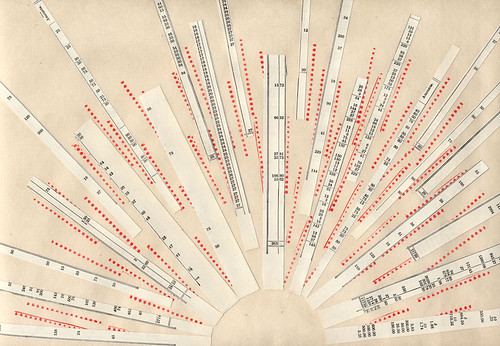Tsilli Pines' series, "The Figures", touches on that in an incredibly eloquent and subtle way, incorporating the printed page, delicate stitching, and pigment (red and black). The stitching serves as a path that allows us to traverse through the jungle of numbers and obstacles that face us on a daily basis. Choosing which path to follow, sifting through jumbled, complex information, and eventually conquering and moving past adversity are all things we, as humans, but more specifically (in this work, at least) as consumers and citizens of a wealth-based society, see throughout our lives.
The question is: are we cognizant of this journey? Yes, we all hate being on hold with the bank, paying mostly interest on our mortgage payments, and fighting tooth and nail to make a living while barely getting by. All of these have to do with numbers, rates, formulae, etc., and we associate these different experiences with corresponding emotions (getting a check for +$1,000 makes Zach happy, getting a cable bill for -$120 makes Zach grumpy).
If I were to ask you what your financial picture was, maybe you'd say something like "it's okay", or perhaps you'd rattle off a list of positive and negative numbers that add up to something that you've decided is indicative of "where you are right now". But do we really know where we are, or how we got here? This is the challenge of "The Figures".
While I usually find that numbers guide me and help me find my way, in this work they served in opposition to the route I sought, something I find simultaneously frustrating and delightful. The phrases and concepts we routinely consider (which serve as her titles: "Risk Tolerance", "Bad Credit", "Balloon Payments", etc.) are visually represented by the charts, plotted graphs, familiar shapes and symbols of financial culture which we are constantly bombarded with. The circles are analogous to both the cyclic nature of finance and the possibility sets of our decisions, while the use of red and black alludes to our favorite fiscal euphemism (I've always found it fascinating how being "in the red" has become a substitute for "we're totally fucked").
Cutting Losses, Tsilli Pines (2007)
In their literal form, they make up our financial identity. But when reduced, arranged, and presented in this form, these numbers tell a story far more confusing and convoluted than I previously imagined anyone's "financial picture" could be, blurring the lines between our true financial reality and the two-dimensional world that Pines has created in this series.
After looking at and thinking about Tsilli Pine's work, I'm left wondering if all of the numbers I surround myself with are compliments or impediments to my daily life. The $2.44 (-$2.44) coffee I had this morning could have been saved, and if I repeated that on a daily basis over the course of a year, I could have almost $900 (+$890.60) saved up, which I could use to pay off a credit card (-$643.26) that I'm paying a ridiculous interest rate on (19.99% APR) when I should be putting those finance charges into my savings account (+1.4% APY) to save for retirement (~40 years away).
Thoughts like this used to give me joy, knowing that if I played the numbers right I could navigate through all of these figures and end out "on top". Work like Pines' challenges this notion, taking the numbers out of the forms we are familiar with and creating a structure which we are vaguely familiar with but inexplicably unable to escape.
So I'm left stalled in one of these drawings, looking at the numbers, and not knowing what to do with them or where to go. And for the first time in a while, I'm comforted by that discomfort, and curious how far not going anywhere will take me. And that's a pretty awesome place to be.
Tsilli Pines is a designer and artist based in Portland, Oregon.


Hi Zach – Thanks so much for your thoughtful consideration of my series. I'm fascinated by how much the numbers mean -- i.e. what we allow them to mean. These pieces were just the first part of a longer examination about the role numbers play in our lives. I feel the same way you do about being surrounded by and conscious of them. There's still a lot of thinking left to do.
ReplyDeleteHi Tsilli! Wow, thanks for replying, it's always cool to get the artist's take on their work. What other incarnations of the number theme have you been experimenting with? Numbers have always been fascinating to me; we have this need to count, meter, weigh, order and grade things that on one hand makes perfect sense but on the other fills our days with these weird, obtuse symbols that soon dictate our behavior and define the direction of our lives. Your work really drove that home; I saw it over a year ago and it's stuck with me ever since.
ReplyDeleteHello again! The fact that the series has stuck with you for this long is the highest praise I could hope for -- thank you!
ReplyDeleteI'm doing the initial research and thinking for a larger series about valuation. You're getting at the exact thing that fascinates me about numbers: how they correlate to concrete decision-making, especially when they don't seem to correlate logically. "The Figures" was something I started by accident -- they emerged when I was doing some non-directed exploration in collage.
After I did the series, I realized that I had only scraped the surface of something far deeper and more interesting. It will take me the next year or two to create the new work. I only have the faintest grasp of what it will be right now, but it's going to be somewhere in this terrain.